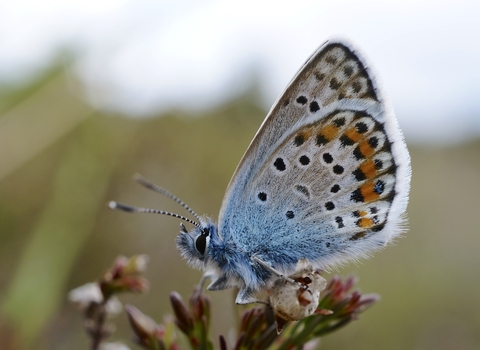
©Guy Edwardes/2020VISION

©Chris Gomersall/2020VISION

©Chris Gomersall/2020VISION
Silver-studded blue
Scientific name
Plebejus argusWhen to see
June to AugustSpecies information
Category
Statistics
Wingspan: 2.6-3.2cmAbout
The silver-studded blue emerges in June and is usually on the wing until late August. It is a rare butterfly, generally found in heathland habitats that have shorter, sparsely vegetated areas. It is restricted to close-knit colonies in southern England and Wales. Two subspecies can be found in its range, while two others are now extinct in the UK. The larvae feed on a wide variety of plants, such as bell heather, cross-leaved heath and gorses.How to identify
The silver-studded blue is a small butterfly which gets its name from the light blue reflective 'studs' (scales) found on the underside of the wings. The upper wings are blue with a dark outer rim. Males are bluer than females, which are more of a dull brown.Distribution
Restricted to specific sites in southern England, eastern England, Wales and Shropshire.In our area
In Shropshire, we have the only site in the West Midlands where the endangered silver-blue butterfly can be found. Prees Heath Common Nature Reserve near Whitchurch has been restored to open heathland for the butterfly and can be visited by the public throughout the year. The site was used for warfare training during WWI and as a bomber airfield during WWII. The old aircraft control tower is still present and provides a reminder of part of the areas past history. Following a public appeal which Shropshire and Cheshire Wildlife Trusts were both involved with, the site was bought by The Butterfly Conservation. Shropshire Wildlife Trust have bought the adjoining site Prees Heath East - this extension has been purchased to act as a satellite site for the butterfly, supplying additional suitable habitat for them to thrive in.
Did you know?
The caterpillars of the silver-studded blue have a close relationship with ants! The ants protect the caterpillars from predators and parasites, in return they get to feed on a sugary substance that the caterpillars produce. When the caterpillars are ready to pupate, they do so in a shallow chamber just below the ground - often in ant nests. The ants will attend the pupa just as they did the caterpillar, and can even be seen swarming around the newly-emerged adult butterflies, offering them some protection as they wait for their wings to dry.Watch
Silver-studded blue (https://vimeo.com/477643412)
Silver-studded blue ©Tom Hibbert
In Shropshire, we have the only site in the West Midlands where the endangered silver-blue butterfly can be found. Prees Heath Common Nature Reserve near Whitchurch has been restored to open heathland for the butterfly and can be visited by the public throughout the year. The site was used for warfare training during WWI and as a bomber airfield during WWII. The old aircraft control tower is still present and provides a reminder of part of the areas past history. Following a public appeal which Shropshire and Cheshire Wildlife Trusts were both involved with, the site was bought by The Butterfly Conservation. Shropshire Wildlife Trust have bought the adjoining site Prees Heath East - this extension has been purchased to act as a satellite site for the butterfly, supplying additional suitable habitat for them to thrive in.

